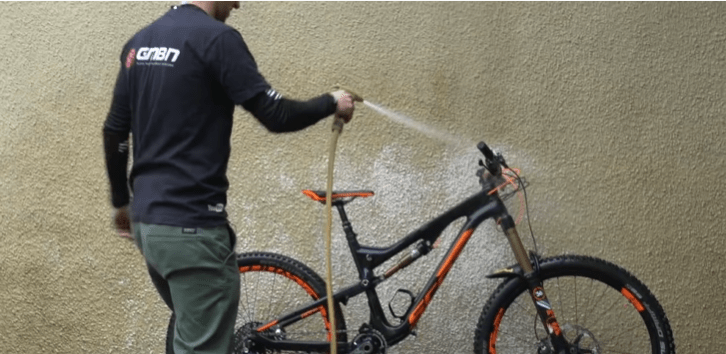

It’s settled, the beginning of the academic year signals a transition in your routine, and it starts with getting back into sports. Jogging has never been your cup of tea, so you opt to dust off your bike from the attic to hit the roads.
However, your trusty road bike has been gathering dust for a while and is not fit for use as it is, otherwise you risk losing some parts on the way. It’s time for a maintenance check!
Firstly, I always start by stabilizing my bike. Although my personal bike is a Btwin Ultra AF 700 road bike, the process is the same for any bike. Fixie bikes are faster to maintain as they don’t have cassettes or multiple chainrings to clean.
There are multiple methods to stabilize your bike, but in my opinion, the most efficient (albeit expensive) way is to use a workshop stand for bikes. I recommend the 500 B’Twin model, which I frequently use for both my road bike and mountain bike. For heavier bikes such as pedelecs and mountain bikes weighing over 22 kg, the PCS-10 workshop stand from the reputable Park Tool brand is a great option.
I prefer using a workshop stand for a few reasons:
A workshop stand is a bike mount equipped with a jaw that holds your bike at the level of the seat post, allowing you to clean and maintain it without stooping down. This is a high-end way to keep your bike clean.
If you have an XS-sized bike with a short seat post, the jaw can also work horizontally when tilted. This makes it possible to hang all types of bikes, including children’s bikes.
If you don’t have the space or need for a workshop stand, you can place your bike upside down, resting it on the handlebars and saddle. However, make sure to protect these parts with a piece of cardboard or fabric to prevent them from scratching on the ground.
If you’re experienced, you can even take the wheels off to make cleaning easier. But it’s worth noting that it’s not mandatory to turn your bike over, and you can complete all maintenance tasks with the bike upright.
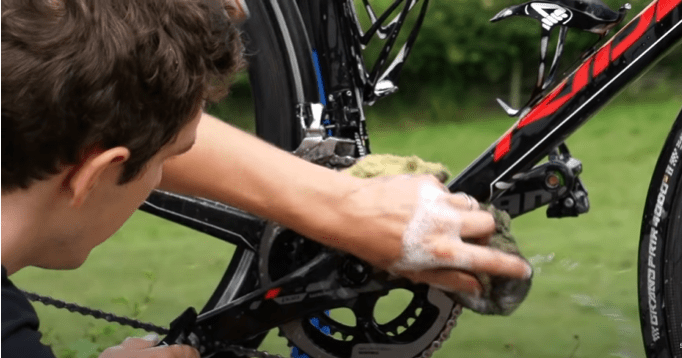

As a reminder, I use my road bike for my daily commute in the Paris region, which exposes it to all kinds of weather conditions and terrain, including rain and dirty paths.
I aim to clean my bike at least twice a month, but sometimes more frequently, for instance, when the bike chain starts to creak after two hours of riding during a thunderstorm, which can strip the transmission.
To clean my bike without spending too much time on it, I use the following maintenance products:
Since I’ve done several cyclocross rides, I’ve bought a 5-liter container of lubricant for cost reasons.
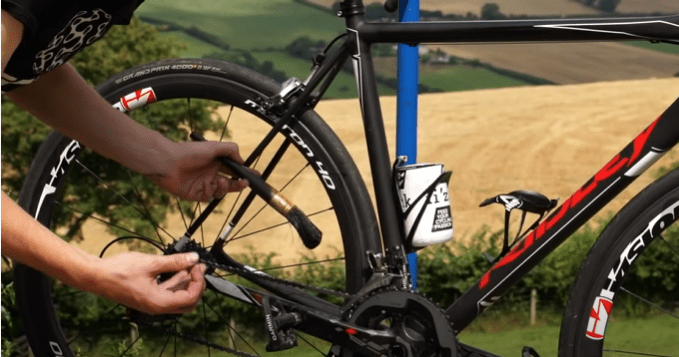

Cleaning your bike is an essential part of maintenance, and it’s important to use environmentally friendly products. I recommend using a 100% biodegradable cleaner that can be easily sprayed on all parts of the bike, including the framework, fork, handlebars, pedals, cassette, chain, and derailleurs.
The Muc-Off cleanser is a great option that can be left to act for 3 to 5 minutes before rinsing off with a simple jet of water. If the cassette is particularly dirty, you may need to use a degreaser to remove all the dirt and grime.
To clean the pedals, brakes, and spokes, use a toothbrush to get into all the nooks and crannies. And don’t forget to protect any non-waterproof parts, such as the saddle, with a waterproof bag.
It’s important to avoid using a high-pressure water jet, as this can damage the bearings of your bike. Instead, a simple jet of water is sufficient to rinse off any dirt and grime.
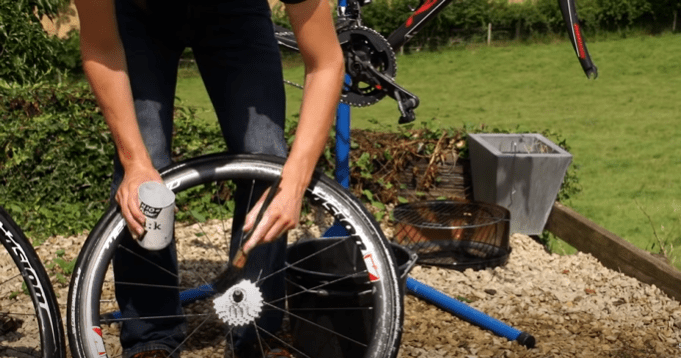

Keeping your transmission clean is essential for the efficient functioning of your bike. The lubricant that protects the chain acts as a glue, trapping all the dust and dirt that come from the road.
When the transmission gets dirty, you may hear a friction noise while pedaling. This is a sign that it’s time to clean it.
If you haven’t cleaned your bike for weeks, the drivetrain may be completely covered in dirt, which can cause the chain to skip gears. I recommend using a degreaser to clean the transmission.
Muc-Off has a biodegradable degreaser that is very effective and environmentally friendly. Other brands like WD-40 Bike also offer good degreasers.
Using a degreaser is economical because you only use it for this purpose, and you can clean your bike more than ten times with one bottle. Avoid using dishwashing liquid to clean your transmission, as it doesn’t work well with the lubricant on the chain, which is designed to resist water.
For hard-to-reach places, you can use an old toothbrush or invest in a complete cleaning kit like Muc-Off, which contains abrasion-resistant brushes. Be prepared to put in some elbow grease for about 5 minutes to get your transmission clean.
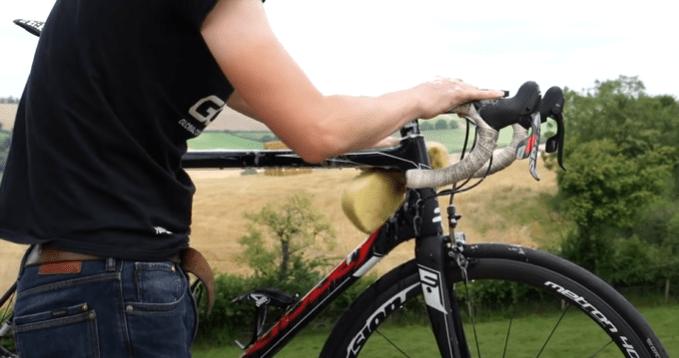

If your transmission is relatively clean, follow these steps:
If your transmission is very dirty and the cleaner did not remove all the grime, add a degreasing step:
If it’s sunny and a little windy, the bike will dry quickly. You can also use an air compressor to blow the water off the bike and leave no trace.
Remember to clean and degrease your bike’s transmission regularly to avoid friction noise when pedaling and keep your bike in good condition.
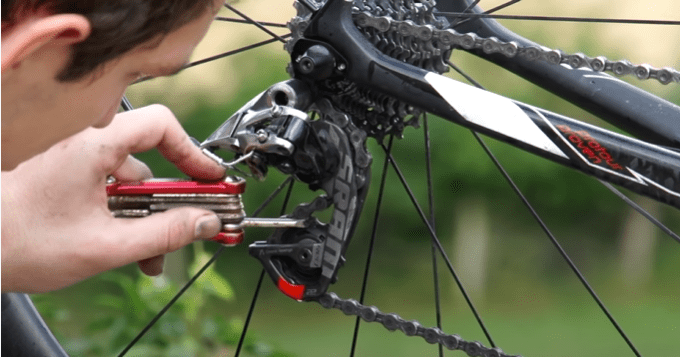

To ensure your bike’s transmission lasts longer, it is crucial to lubricate its components regularly.
This helps prevent premature wear and tear on the chain and keeps the transmission running quietly, making it easier to shift gears.
You have many products to choose from for lubrication. Ideally, use grease, often in paste form, to maintain mechanical assemblies such as seat tubes and stems. Use oil for the transmission elements, which are the moving parts.
There are different types of oils available for different weather conditions. For dry weather, use a more fluid and less sticky oil like WD40 or Muc-Off. For wet or rainy weather, use a thicker and more adhesive oil like WD40 or Muc-Off. Some brands offer all-weather lubricants that work well in any condition, such as Finish Line, Zefal, or Teflon (which reduces friction). Personally, I use an all-weather oil with Teflon.
To apply the oil properly:
Be careful not to apply too much oil, or it will likely spray onto your right calf while pedaling.
Regularly lubricating the chain, rollers, and derailleur is crucial, even if you don’t clean your bike every time. If the transmission is too dirty, you need to clean it completely by degreasing all the elements to start again on a healthy basis.
Lastly, take advantage of this moment to boost your pretty leather saddle by using oil specially designed for leather or moisturizing milk to soften the material.
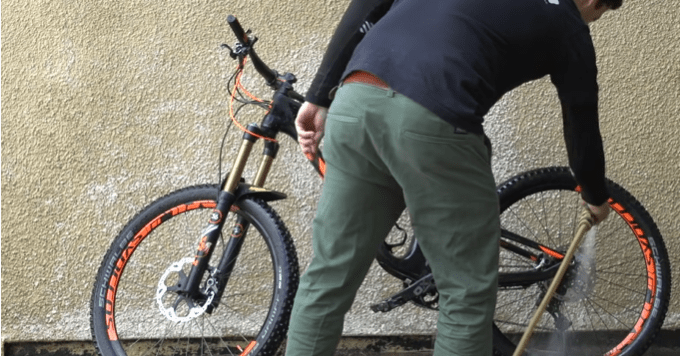

Once you have followed the steps outlined in this guide to maintain your bike properly, you can finally take it out and enjoy riding it as it deserves.
In summary, remember that regular maintenance is the key to success and involves quick cleaning after each ride. Keep in mind that proper cleaning and regular lubrication are just as important whether you are riding a road bike or a mountain bike.
After following the steps, your cassette and bike should look cleaner, and you can dry them off. I prefer using Muc-off products as they are reasonably priced and biodegradable.
